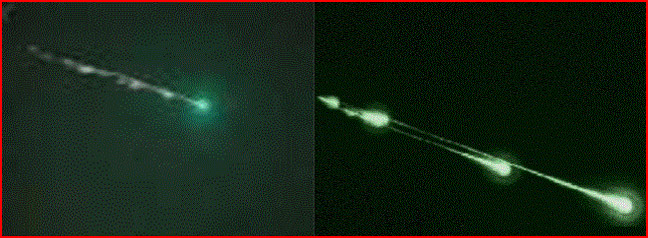
home •
about •
essential guide •
picture of the day •
thunderblogs •
news •
multimedia •
predictions •
products •
get involved •
contact
picture of the day archive subject index
Jun 01, 2006
The Peekskill MeteorBolides that flicker, flare up and explode as they streak toward the earth pose unanswered questions for scientists. Why do most meteors become visible to the eye when they are about 60 miles in altitude but a few appear at up to twice that height? Why are some meteors accompanied by electrophonic sound that is simultaneous with their flaring up?
In the evening of October 9, 1992 a fireball appeared in the sky over West Virginia. This distinctively green-hued fireball traveled visibly over 700 km in 40+ seconds. Thousands of people saw it, and dozens reported observations that enabled scientists to determine its path and behavior. At least 16 different witnesses videotaped it.
At some point in its flight this meteoric fireball fragmented with significant longitudinal displacement of fragments and slight transverse displacement for some of the fragments, both of which can be seen in the photos above. Before fragmentation, though, the meteoric fireball left a distinctly flickering wake trail. Also during its flight the fireball flared twice dramatically, reaching a brightness exceeding that of a full moon. Some witnesses describe an explosive "pop" before it "burst into a rainbow of colors".
One observer commented: "When I saw it, it was still in one piece. It was an electric lime green with tendril-like extensions. It did not look like it was burning up so much as undergoing an electrical interaction. In the photo after fragmentation, one can notice the electric coma on the lead meteor."
Many witnesses described hearing electrostatic noises or "crackling" sounds just before and for several seconds after fragmentation. Since the fragmentation took place at an altitude of about 41.7 km (26 miles) in a vacuum where there is NOT enough atmosphere to carry sound, how did this electrophonic noise propagate for over 25 miles?
See “Electrophonic sounds from large meteor fireballs”, Keay, Colin S.L., Meteoritics (ISSN 0026-1114), vol. 27, no. 2, June 1992, p. 144-148. Research supported by Herzberg Institute for Astrophysics, Queen Mary and Westfield College, and SERC.
Quote from the abstract of the article given on:
“Anomalous sounds from large meteor fireballs, anomalous because they are audible simultaneously with the sighting, have been a matter for debate for over two centuries. Only a minority of observers perceive them. Ten years ago a viable physical explanation was developed (Keay, 1980) which accounts for the phenomenon in terms of ELF/VLF radiation from the fireball plasma being transduced into acoustic waves whenever appropriate objects happen to be in the vicinity of an observer. This explanation has now been verified observationally and supported by other evidence including the study of meteor fireball light curves reported here”.
Astrophysicists try to calculate the original mass of the Peekskill bolide from the total energy released. They present a value range from 2 to 25 tons, but these calculations give no consideration to electric charge and electric forces. In the Electric Universe view, any object coming far from the earth would be charged differently. As it encounters lower layers of the Earth's plasma sheath, the voltage between the object and the layer would increase and the object would begin to discharge visibly.
At first it would be surrounded by a “glow discharge”, a diffuse luminescence similar to St. Elmo’s fire or to high-altitude “elves”. As the voltage increased, the discharge would jump to “arc” mode, and the object would become an electrode at the focus of upper-atmospheric charge. At this point it would begin to ablate material in a discharge process as well as from velocity-caused air friction.
Since there is no indication of oxidizable elements associated with the recovered fragment, it is unlikely that the flareups were caused by chemical reaction. The most likely explanation is that of its running into a more highly charged region. Regardless, the total energy released would always be the combination of kinetic energy, chemical energy and electric energy.
One significant question needs to be answered. At about 50 km (31 miles) above the Earth's surface, is there enough material in space to begin a friction ablation process for an object traveling 14.7km/s (32.9 thousand mph)? If not, one is justified to conclude that electrical interaction took place to initiate the glow and flareups. Others have misgivings concerning the adequacy of friction ablation, also. See:
http://xxx.lanl.gov/abs/astro-ph/0505288
Luminescence above 100 km (60 miles) has been noticed not only with meteors but also with spacecraft. Russian scientists in the 1960s noticed the sudden appearance of infrared radiation and light around their rockets between 100 and 160 km (60 to 100 miles).
One proposed explanation, with which the Electric Universe would agree, is that meteors (and spacecraft) trigger the formation of instabilities in plasma layers. The energy of the flickering and flaring, as well as of the low-frequency radiation, comes more from the ionospheric plasma than from the meteoroid. The meteors that we’ve come to think of as “burning up in the atmosphere” may instead be the targets of mini-thunderbolts from the ionosphere.
Composed by Jim Payette and Michael Armstrong
________________________________________________________________________________________________Please visit our Forum
The Electric Sky and The Electric Universe available now!

|
|

|
EXECUTIVE EDITORS:
David Talbott, Wallace Thornhill
MANAGING EDITOR:
Michael Armstrong
CONTRIBUTING EDITORS: Dwardu Cardona, Ev Cochrane,
C.J. Ransom, Don Scott, Rens van der Sluijs, Ian Tresman
WEBMASTER: Michael Armstrong
Copyright 2006: thunderbolts.info
![]()
home •
thunderblogs •
forum •
picture of the day •
resources •
team •
updates •
contact us

